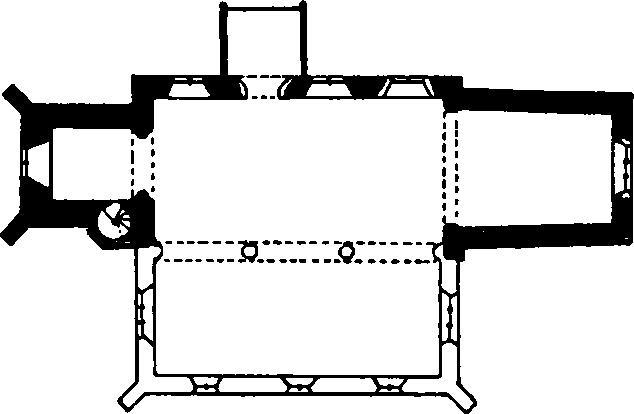An Inventory of the Historical Monuments in Essex, Volume 3, North East. Originally published by His Majesty's Stationery Office, London, 1922.
This free content was digitised by double rekeying. All rights reserved.
'Layer de la Haye', in An Inventory of the Historical Monuments in Essex, Volume 3, North East(London, 1922), British History Online https://prod.british-history.ac.uk/rchme/essex/vol3/pp154-155 [accessed 7 February 2025].
'Layer de la Haye', in An Inventory of the Historical Monuments in Essex, Volume 3, North East(London, 1922), British History Online, accessed February 7, 2025, https://prod.british-history.ac.uk/rchme/essex/vol3/pp154-155.
"Layer de la Haye". An Inventory of the Historical Monuments in Essex, Volume 3, North East. (London, 1922), British History Online. Web. 7 February 2025. https://prod.british-history.ac.uk/rchme/essex/vol3/pp154-155.
In this section
53. LAYER DE LA HAYE. (C.d.)
(O.S. 6 in. xxxvi. N.E.)
Layer de la Haye is a parish and small village 4 m. S.W. of Colchester. The church is interesting.
Ecclesiastical
(1). Parish Church (dedication unknown) stands near the middle of the parish. The walls are of mixed rubble and septaria, with dressings of limestone; the roofs are tiled. The S.E. angle of the nave is of the 12th century and the Chancel from its form and the absence of buttresses is probably also of early date, but all definite evidence is concealed by cement. The Nave was rebuilt c. 1350 and the West Tower and North Porch added about the middle of the same century. The chancel-arch was built in the 15th century. The church was restored in the 19th century, when the South Aisle was added and the N. wall of the nave refaced or rebuilt.

The Church, Plan
Architectural Description—The Chancel (21 ft. by 15½ ft.) has an E. window, all modern except the two-centred rear-arch. In the S. wall are two blocked windows, but in both cases the head has been destroyed and they are of uncertain date. The 15th-century chancel-arch is two-centred and of two hollow-chamfered orders, the outer continuous and the inner carried down as a plain chamfer on to the hollow-chamfered base.
The Nave (39½ ft. by 21 ft.) has S.E. quoins of Roman brick. In the N. wall are three windows; the easternmost is modern and the two western are of the 14th century, partly restored, and each of two trefoiled ogee lights with a quatrefoil in a two-centred head with a moulded label; between these two windows is the modern N. doorway. The S. arcade is modern.
The West Tower (11¼ ft. by 10 ft.) is of c. 1350 and of three stages with an embattled parapet. The two-centred tower-arch is of two continuous chamfered orders, hollow in the arch and plain in the responds, with hollow-chamfered bases. In the S. wall is a doorway to the stair-turret, with chamfered jambs and two-centred arch; a blocked doorway of similar form and at a higher level indicates the former existence of a gallery. The W. window is of two cinquefoiled lights with a quatrefoil in a two-centred head with a moulded label. The second stage has in both the N. and W. walls a window of one trefoiled light in a square head with a moulded label. The bell-chamber has in each wall a similar window, but of two lights.
The North Porch is timber-framed, the outer archway being formed with a cambered tie-beam and two curved braces; the gable has mid 14th-century trefoiled and sub-cusped barge-boards, the top main cusp being of ogee form.
The Roof of the nave is of trussed-rafter type and probably of the 14th century. The roof of the N. porch has moulded wall-plates and chamfered tie-beams of the 14th century.
Fittings—Bells: five; 1st by Miles Graye, 1673; 2nd by Johanna Sturdy, inscribed "In Multis Annis Resonet Campana Johannis I.S.," mid 15th-century; 3rd by Miles Graye, 1622. Bell-frame, probably 15th-century. Monument: In chancel—against N. wall, altar-tomb of Purbeck marble with moulded edge and plinth, defaced panelling in front, recessed canopy with coved and quatrefoiled vault, flanked by attached shafts and surmounted by a frieze with a band of quatrefoils and carved cresting, early 16th-century. Piscina: In chancel—with hollow-chamfered jambs and trefoiled head, round drain, 15th-century. Plate: includes a late 16th-century cup with a band of incised ornament and a stem probably of later date; the late 16th-century cover-paten has the sacred monogram.
Condition—Fairly good, but some ivy on tower.
Secular
(2). Homestead Moat, at Rye Farm, ½ m. E.N.E. of the church.
(3). Blind Knights, house, about ¾ m. E. of the church, is of two storeys, timber-framed and plastered; the roofs are tiled. It was built possibly in the 15th or early in the 16th century, with a cross-wing at the W. end and later additions beyond it. The upper storey projects on the N. side of the original building and some of the timberframing is exposed.
Condition—Fairly good.
(4). Great House Farm, house, about ¾ m. N.E. of the church, is of two storeys, timber-framed and faced with modern brick; the roofs are tiled. It was built in the 15th century, with a central hall and cross-wings at the E. and W. ends. Inside the building are some exposed ceiling-beams and the W. wing has an original roof with a king-post truss.
Condition—Good.
(5). Cottage, on S. side of road, 1,200 yards N. of the church. It is of two storeys, timber-framed and plastered; the roofs are thatched. It was built early in the 17th century and has exposed timber-framing inside the building.
Condition—Good.
(6). Cottage, two tenements, ½ m. N.E. of (5), is of two storeys, timber-framed and plastered; the roofs are tiled. It was built early in the 16th century, with a cross-wing at the W. end. Inside the building the timber-framing and ceiling-beams are exposed.
Condition—Poor.
